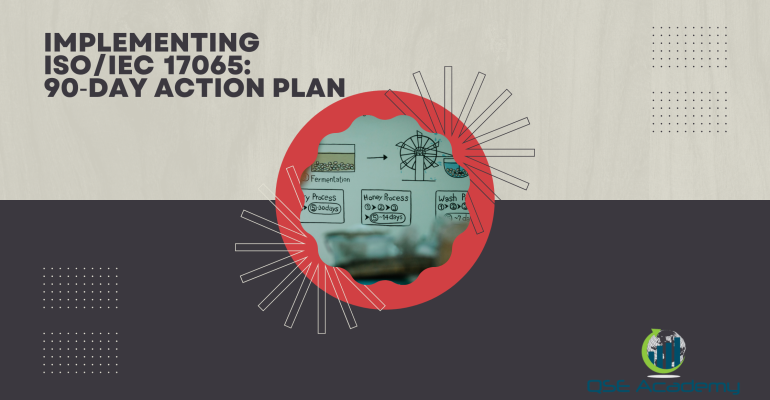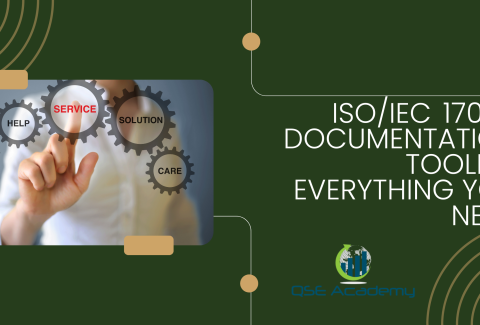Implementing ISO/IEC 17065: 90‑Day Action Plan
A Clear 90-Day Roadmap Makes ISO/IEC 17065 Implementation Achievable
Most certification bodies overcomplicate their ISO/IEC 17065 journey because they don’t have a timeline. They jump between clauses, rewrite documents multiple times, and lose momentum. What they need first is structure — not paperwork.
At QSE Academy, we’ve built, tested, and refined accelerated implementation plans for certification bodies worldwide. With the right sequence and task order, even small teams can move quickly and stay compliant.
This 90-day action plan gives you a clear, practical path to build your ISO/IEC 17065 system from scratch. You’ll know exactly what to do each month, which clauses to prioritize, and how to validate your system before assessment.
And yes—speed is possible. One certification body we supported achieved full system readiness in just 90 days because they followed a structured roadmap, kept responsibilities clear, and focused on essentials first.
Understanding the 90-Day Strategy: Why Speed Requires Structure
A fast implementation doesn’t happen through multitasking. It happens through logical sequencing. ISO/IEC 17065 requirements build on each other, and trying to implement everything at once only creates confusion.
The entire 90-day method is built on three principles:
- Phase 1: Build the organizational foundation.
- Phase 2: Build the certification process.
- Phase 3: Build the management system and validate effectiveness.
Everything else fits inside these three phases.
Pro Tip: Assign one decision authority for documentation and interpretation during the first 90 days. It reduces delays and improves consistency.
Common Mistake: Writing detailed operational procedures before finalizing policies and structure. Always build the foundation first.
 Days 1–30: Establish the Foundation (Clauses 4, 5, and 6)
Days 1–30: Establish the Foundation (Clauses 4, 5, and 6)
Phase 1: Build Leadership, Structure, Impartiality, and Competence Controls
The first 30 days are about setting up the organizational strength behind your certification body. If this phase is weak, everything else becomes unstable.
Core Tasks
- Set up legal entity validation, liability coverage, and financial safeguards.
- Establish the impartiality framework and impartiality committee.
- Define organizational structure, roles, responsibilities, and reporting lines.
- Create your competence matrix and begin training needs identification.
- Draft high-level policies: impartiality, confidentiality, complaints, appeals.
- Begin shaping your certification scheme based on your product category.
Pro Tips
- Document every structural decision as you go. It becomes your evidence trail later.
- Align roles to responsibilities honestly — auditors immediately detect mismatches.
Common Pitfalls
- Giving the same person too many roles without documented impartiality safeguards.
- Writing long procedures too early instead of establishing governance first.
Days 31–60: Build the Certification Process Framework (Clause 7)
Phase 2: Document and Validate the Certification Workflow
This phase is where your certification system takes shape. You move from structure to action.
Core Tasks
- Map your certification process from application to decision and surveillance.
- Create evaluation procedures, decision criteria, and technical-review steps.
- Develop templates: evaluation reports, review logs, and decision records.
- Build complaints and appeals procedures with clear timelines and responsibilities.
- Train technical staff on evaluation techniques and scheme-specific requirements.
- Ensure traceability from evaluation → review → decision.
Pro Tips
- Standardize forms to avoid unpredictable interpretations.
- Maintain alignment with ISO/IEC 17065 requirements but keep procedures practical.
Common Pitfalls
- Designing a certification process that doesn’t match your actual capacity.
- Missing documentation that links evaluation results to certification decisions.
Days 61–90: Build the Management System & Validate Effectiveness (Clause 8)
Phase 3: Implement, Audit, Review, Improve
By this stage, your system exists. Now you validate it, test it, and prepare it for accreditation.
Core Tasks
- Establish full document-control procedures, including versioning and retention.
- Conduct an internal audit covering Clauses 4–8.
- Perform a management review and document outputs: risks, KPIs, resources.
- Complete corrective actions and update evidence.
- Prepare for accreditation body application or pre-assessment.
Pro Tips
- Use KPIs like “% of documents approved,” “% competence verified,” and “% internal audit findings closed” to show control.
- Keep your corrective actions precise and evidence-based — vague actions fail audit scrutiny.
Common Pitfalls
- Rushing through internal audits. They must evaluate effectiveness, not just existence.
- Leaving minor findings unresolved — assessors expect closure.
Detailed Weekly Checklist: What to Do, Week by Week
To keep implementation manageable, break it down further:
Weeks 1–2
- Set legal and impartiality framework.
- Approve organization structure and responsibility matrix.
Weeks 3–4
- Finalize competence matrix.
- Roll out first training activities.
Weeks 5–6
- Draft certification-scheme structure.
- Map evaluation and decision pathways.
Weeks 7–8
- Finalize certification procedures and forms.
- Train staff on evaluation and decision processes.
Weeks 9–10
- Implement document control and recordkeeping.
- Finalize evidence templates and consistency checks.
Weeks 11–12
- Conduct internal audit and management review.
- Close any findings and validate implementation.
Week 13
- Perform system readiness check.
- Submit application or schedule pre-assessment.
Pro Tip: Use a simple dashboard — even an Excel sheet — to track task owners and due dates.
Tools and Templates That Accelerate the 90-Day Plan
You don’t need expensive software to implement ISO/IEC 17065. You need clarity and tools designed for clause alignment:
- Gap-analysis checklists.
- Certification-scheme templates.
- Evaluation and decision forms.
- Competence matrices.
- Project-plan trackers.
- Document-control templates.
- Internal audit forms and management-review templates.
Staying on Track and Meeting Accreditation Expectations
Maintaining momentum is essential. Here’s how to keep the plan moving:
- Hold short weekly check-ins with leadership.
- Assign clear accountability and track completion visually.
- Review impartiality risks monthly.
- Avoid scope changes during the 90 days — they slow everything down.
- Maintain quick feedback cycles between technical and quality teams.
Pro Tip: Treat this 90-day plan as your minimum viable system. Enhancements can follow after accreditation.
FAQs
Q1: Can ISO/IEC 17065 implementation realistically be completed in 90 days?
Yes — if responsibilities are defined early, documentation is structured logically, and tasks are executed in the correct order.
Q2: What team size is needed to follow this plan?
Minimum three roles—quality lead, technical lead, administrative support. Some roles may overlap if impartiality is controlled.
Q3: What if we fall behind the timeline?
Pause, reset, and continue in sequence. Don’t skip foundational tasks to catch up. Structure matters more than speed.
Conclusion: A 90-Day Plan Works When It’s Structured, Focused, and Executed Consistently
Speed without structure leads to rework. Structure without speed leads to delays. A 90-day plan gives you both — clarity and momentum.
With the right sequencing and commitment, certification bodies of any size can reach system readiness quickly and confidently.
Next step: Download the ISO/IEC 17065 90-Day Implementation Kit and start executing your plan with clarity and control today.
Melissa Lavaro is a seasoned ISO consultant and an enthusiastic advocate for quality management standards. With a rich experience in conducting audits and providing consultancy services, Melissa specializes in helping organizations implement and adapt to ISO standards. Her passion for quality management is evident in her hands-on approach and deep understanding of the regulatory frameworks. Melissa’s expertise and energetic commitment make her a sought-after consultant, dedicated to elevating organizational compliance and performance through practical, insightful guidance.









